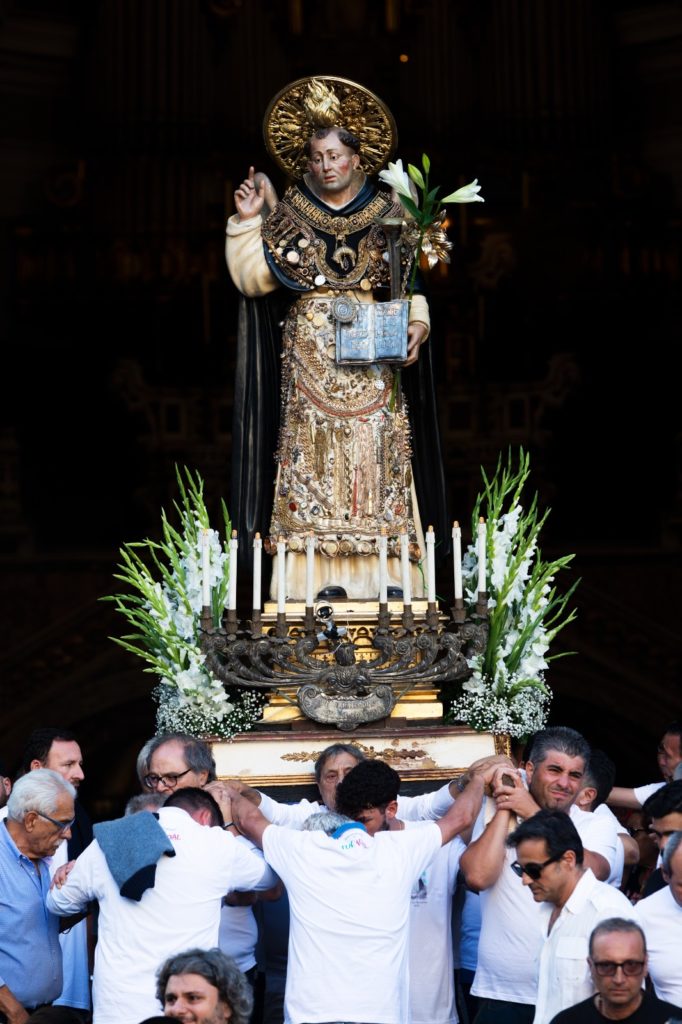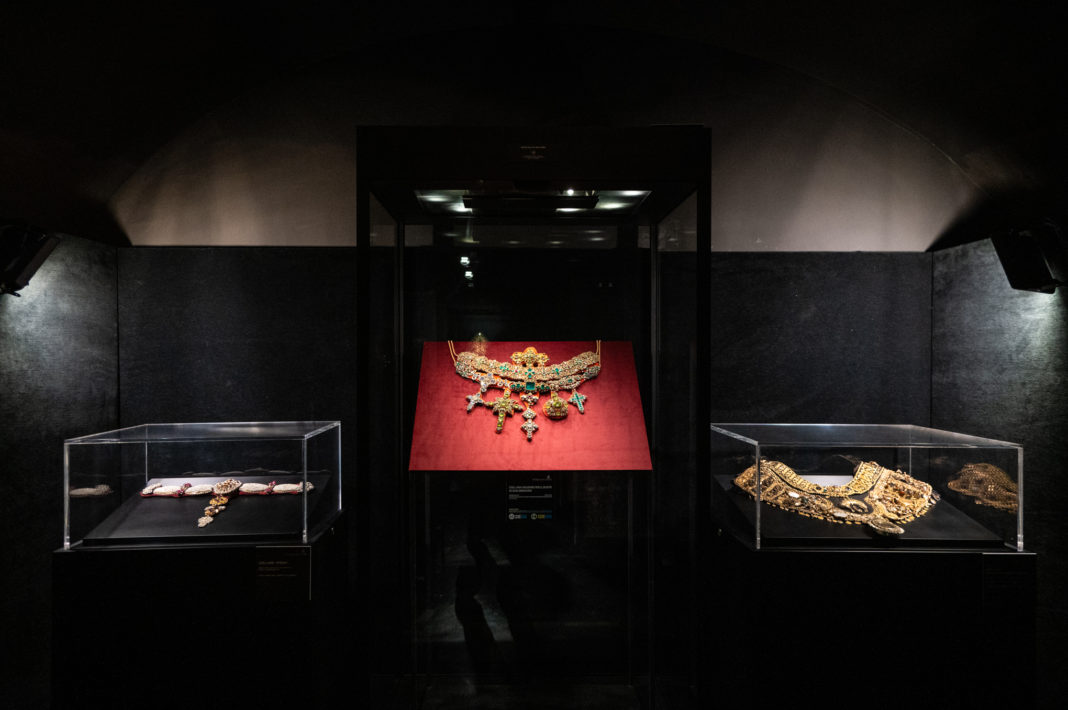“Tre collari. I gioielli della devozione”. Da oggi, giovedì 14 marzo (fino al 14 maggio, con catalogo pubblicato da D’Uva), il Museo del tesoro di San Gennaro propone la mostra curata da Laura Giusti: tre simboli religiosi dialogano per la prima volta tra loro.
Il collare di San Vincenzo Ferrer, storico protettore del quartiere Sanità, conservato nel Museo Diocesano di Napoli e di proprietà del Fondo edifici di culto, il collare solenne di San Gennaro, di valore inestimabile, che conserva le offerte di sovrani e regnanti, e il collare donato dalla famiglia Spera al patrono partenopeo.
Così l’arte s’intreccia con storia e fede: nella sala della mitra, si possono ammirare anche le immagini (foto di Simone Florena) che ritraggono la statua lignea di San Vincenzo e il busto reliquario di San Gennaro con i preziosi pettorali.
L’iniziativa parte dalla ricerca scientifica di Laura e Paola Giusti sulla storia dei bellissimi ornamenti, con approfondimenti inediti che hanno permesso di aggiungere particolari sulla loro storia.
Il collare solenne, con migliaia di pietre preziose fra smeraldi, rubini, zaffiri e diamanti (donati da re e regine o acquistati dalla Deputazione del Tesoro di San Gennaro) ebbe origine nel 1679, quando la Deputazione commissionò all’orafo Michele Dato l’attuale fascia superiore del gioiello.
Nel XIX secolo fu trasformato nell’odierno pettorale attraverso un percorso articolato e non ancora del tutto chiarito. Grazie al ritrovamento di un documento del 7 settembre 1825, nell’archivio della Cappella, è tuttavia possibile aggiungere nuovi, importanti tasselli alla ricostruzione della cronologia dell’assemblaggio dei monili, e anticipare di circa vent’anni la prima operazione di montaggio dei gioielli al collare.
Il collare Spera, dono di Giovan Francesco Spera e sua moglie Anna Lucrezia nel 1706 è prezioso esempio di gioielli nati per uso profano adattati a scopo religioso: è chiamato collare feriale (meno appariscente di quello adoperato nelle manifestazioni solenni) e risulta dall’assemblaggio di perle nonché di gioielli più modesti e forma un disegno elegante, un pezzo unico nella storia dell’oreficeria napoletana.
In occasione della mostra è stato possibile, inoltre, studiare per la prima volta il retro dell’opera, in argento, dove sono incisi la data del montaggio, il nome e lo stemma della famiglia Spera.
Infine, il collare di San Vincenzo Ferrer della Basilica di Santa Maria della Sanità, conosciuta come la chiesa di San Vincenzo “’o Munacone” dove vivo il culto per il predicatore domenicano che secondo la tradizione fermò l’epidemia di colera del 1836-37.
Sul collare sono montati monili di valore, contenuto provenienza popolare o piccolo borghese. Il popolo si privava dei suoi gioielli per donarli al santo domenicano ma tutt’ora continua a regalare oggetti che vengono sapientemente composti in un insieme ricco e armonico.
Per saperne di più
www.tesorosangennaro.it
La foto di copertina è di Alessia Della Ragione

Exhibition/ Museum of the treasure of San Gennaro: dialogue between three collars, jewels of devotion
“Three collars. The jewels of devotion”. From today, Thursday March 14th (until May 14th, with a catalogue published by D’Uva), the Museum of the Treasure of San Gennaro proposes the exhibition curated by Laura Giusti: three religious symbols in dialogue for the first time.
The collar of St. Vincent Ferrer, historical patron of the Sanità district, kept in the Diocesan Museum of Naples and owned by the Fund for the Construction of Shrines; the solemn collar of St. Gennaro, of inestimable value, which preserves the offerings of sovereigns and rulers; and the collar donated by the Spera family to the Neapolitan patron saint.
Thus, art is interwoven with history and faith: in the Mitre Room you can also admire the paintings (photo by Simone Florena) representing the wooden statue of St. Vincent and the reliquary bust of St. Gennaro with the precious pecgtorals.
The initiative began from Laura and Paola Giusti’s scientific research on the history of the beautiful ornaments, with unpublished insights adding details about their history.
The solemn collar, with thousands of precious stones including emeralds, rubies, sapphires, and diamonds (donated by kings and queens or purchased by the Deputation of the Treasure of San Gennaro), originated in 1679 when the Deputation commissioned goldsmith Michele Dato to make the current upper band of the jewel.
In the 19th century, it was transformed into today’s pectoral through an articulated process that has not yet been fully clarified. Thanks to the discovery of a document dated September 7, 1825 in the Chapel’s archives, however, it is possible to add new, important pieces to the reconstruction of the chronology of the assembly of the jewelry, and to anticipate by about twenty years the first operation of mounting the jewelry to the collar.
The Spera collar, a gift from Giovan Francesco Spera and his wife Anna Lucrezia in 1706, is a precious example of jewelry created for secular use adapted for religious purposes: it is called a weekday collar (less conspicuous than that used in solemn events) and results from the assembly of pearls and more modest jewels and forms an elegant design, a unique piece in the history of Neapolitan goldsmithing.
On the occasion of the exhibition, it was also possible to study for the first time the back of the work, in silver, where the date of assembly, the name, and coat of arms of the Spera family are engraved.
Finally, the collar of St. Vincent Ferrer from the Basilica of Santa Maria della Sanità, known as the church of St. Vincent “‘o Munacone,” where the cult for the Dominican preacher who, according to tradition, stopped the cholera epidemic of 1836-’37, is still alive.
On the collar, pieces of value, content, and popular or petty-bourgeois origin are mounted. The people deprived themselves of their jewelry to give it to the Dominican saint, but they continue to offer skillfully composed objects into a rich and harmonious whole to this day.
Read more at
www.tesorosangennaro.it










